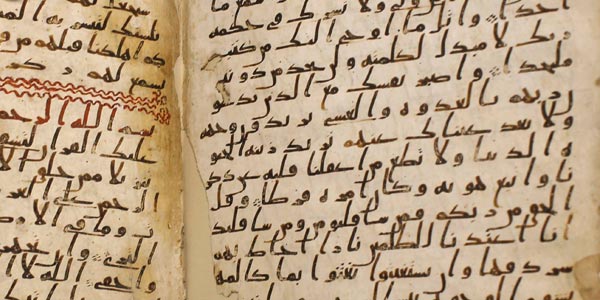Oldest Fragments of the Qur’an

Two parchment leaves of a Qur’anic text dating back to within two decades of Prophet Muhammad’s death, and discovered recently within the Special Collections section of the University of Birmingham, UK, strongly indicate that the Qur’an has remained unchanged from the time of its revelation right up to the present day.
The University of Birmingham has discovered, from its archives, fragments of the Qur’an that could be the oldest. Radiocarbon tests are startling. The copy could be around 1,370 years old. The manuscript had been kept with a collection of other Middle Eastern books and documents, without being identified as Qur’anic. The university’s director of special collections, Susan Worrall, said researchers had not expected “in our wildest dreams” that it would be so old. “Finding out we had one of the oldest fragments of the Koran in the whole world has been fantastically exciting.”
Reports add that the tests, carried out by the Oxford University Radiocarbon Accelerator Unit, revealed that the fragments, written in ‘Hijazi script,’ an early form of Arabic writing, on sheep or goat skin, were among the very oldest surviving texts of the Qur’an. Prof. Thomas, professor of Christianity and Islam, said the dating of the Birmingham folios would mean that, “The person who actually wrote it could well have known the Prophet Muhammad. He would have seen him probably, he would, maybe, have heard him preach. He may have known him personally – and that really is quite a thought to conjure with,” he says.
Prof. Thomas says that, “the parts of the Koran that are written on this parchment can, with a degree of confidence, be dated to less than two decades after Muhammad’s death. These portions must have been in a form that is very close to the form of the Koran read today, supporting the view that the text has undergone little or no alteration and that it can be dated to a point very close to the time it was believed to be revealed.”
Dr. Waley, curator for such manuscripts at the British Library, said “these two folios, in a beautiful and surprisingly legible Hijazi hand, almost certainly date from the time of the first three caliphs.” The manuscript is part of the Mingana Collection of more than 3,000 Middle Eastern documents gathered in the 1920s by Alphonse Mingana, a Chaldean priest born near Mosul in modern-day Iraq.The fragment held in the university’s Cadbury Research Library, was funded by Victorian-era businessman and Quaker philanthropist Edward Cadbury.
Consisting of two parchment leaves, it shows parts of Surahs (chapters) 18 to 20, written with ink in an early form of Arabic script known as Hijazi. It had lain for decades alongside pages of a similar manuscript which dated from the late seventh century. Prof. Thomas says it will show people in Birmingham that they have a “treasure that is second to none.”
[Courtesy: http://www.bbc.com/news/; http://www.thenational.ae/world/; http://www.nbcnews.com/news/ experts-n396331- 22nd July 2015]

